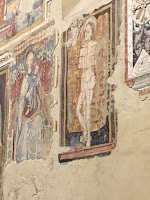As we all know, a couple of weeks ago, Notre Dame in Paris was burning. Watchers around the world were horrified. But a mere twenty-four hours later, things were not looking so bleak. The Crown of Thorns and the beehives on the roof were unhurt by the fire. We received several emails from bee-loving friends with the news of the still-flying bees. But I had to learn of the Crown of Thorn’s escape on my own.

Then we were visiting friends at their exquisitely restored tobacco-drying barn, Bacciana. Montone is a walled town in Umbria, with some lovely restaurants, no decent postcards, and the ex-church of San Francesco featuring frescoes in terrible condition. But of the frescoes that are still extant, there are a cephalophore* and a very young and nubile Saint Sebastian. While roaming around town reading menus, we learned that on every Easter Monday Montone celebrates the Gift of the Holy Thorn (Donazione della Santa Spina) with a day of pageantry, costumes, archery, puppetry, and handsome men in bicolored tights. Religiosity and shapely calves. What could be better?




In the 15th century, the Venetians, grateful for his help in defeating the Turkish invaders, gave Montone’s local squire, Braccio Fortebraccio** a single thorn from the crown of thorns: the Santa Spina. The Venetians had acquired the Crown a couple of centuries earlier, as collateral for a loan made to the warmongering Baldwin II of Constantinople. Baldwin never redeemed the Crown, but Louis IX of France did. Apparently the Venetians held back a few thorns.
If you care to research the history of the Crown of Thorns, and the various extracted thorns, you must be prepared for conjecture, legend, wishful thinking, and contradictions. Also just plain heresy.
Eagerly, I texted my sister that we would be seeing the Holy Thorn in Montone, and wasn’t this a fantastic coincidence, or just plain serendipity, that we would be in Montone for this celebration? She texted back that according to her research (Wiki) there was no Holy Thorn in Montone. I sent her a picture of the reliquary that was featured in the flyers all around town. She sent me a link to the Wiki page enumerating all the cities in Europe claiming one or more thorns. Montone was not among them. Cities in Belgium, France, the Czech Republic, Spain, Germany, Britain, Ukraine and five cities in Italy all lay claim to a portion, or a branch, or a thorn, or a fragment, of the Crown of Thorns. Even a chapel in Pittsburgh, USA, claims a thorn. But not Montone.
This is obviously yet another example of the fact that you can’t believe something just because you read it on the internet. I was in Montone and I saw the Holy Thorn. Well, I didn’t actually see the Holy Thorn because it was inside its special box. It wasn’t even in the beautiful reliquary shown on all the flyers, because at last year’s celebration, there was a touchy moment when the Montonian carrying the reliquary almost fell off his horse. But I did see the special box that was used in lieu of the reliquary. And I know what I saw.
*Cephalo-phore: a saint who has been decapitated and then carries around his/her head. If you don’t know this already, you haven’t been paying attention.
**His Wiki page also does not mention Montone’s Holy Thorn: a dereliction that makes me suspect a possible conspiracy by the other Thorn-Hoarding cities.







2 comments:
Thanks for giving your grateful readers the chance to visit Umbria and the Festival of the Holy Thorn vicariously through your lovely photographs and sensibility!
You must let Wiki know
Post a Comment